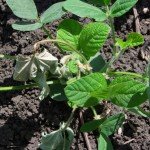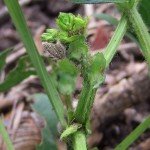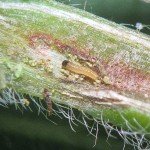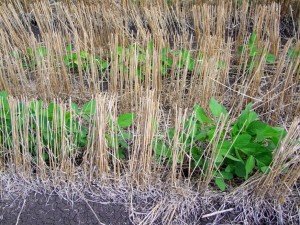Background: Significant etiella outbreaks have recently been reported in soybeans and mungbeans on the Darling Downs, in the South Burnett (SE Qld) and in the Moree and NorthernRivers regions of NSW. In some soybean crops on the Downs, 100% of plants were infested and 72% of axilliary buds damaged to varying degrees. These outbreaks are similar but more widespread than etiella outbreaks reported in January 2013. Etiella damage in soybeans and mungbeans is generally associated with podding crops but the recent outbreaks show infestations in vegetative and flowering soybeans and budding/flowering mungbeans.
At this stage it is not clear why these outbreaks occur. One reason may be the very hot dry seasonal conditions which favour etiella. It should be noted that the January 2013 outbreak ‘crashed’ with the onset of the wet season due to cyclone Oswald. It is also possible that the pest is adapting to a new food source in difficult seasons.
Damage:
In vegetative soybeans, young larvae attack and kill the plant’s axillary buds, which are the precursors to the floral buds. Larger larvae then tunnel in the stem’s pith before exiting the stem to pupate in the soil. This damage reduces the number of potential flower budding sites on the plant and can weaken the plant’s stems. Damaged plants can compensate through producing additional side branches, and/or produce more buds lower on the plant. However, pods set lower down on the plant are more likely to be lost at harvest.
In budding mungbeans, etiella larvae appear to focus on the buds, with no stem tunnelling observed to date. Severe infestations in many budding crops at CecilPlains have required treatment yet some crops at Moree have remained at what consultants deemed to be sub economic levels, possibly due to heavy predation by red and blue beetles.
Identification and Monitoring: In heavily infested crops, the first signs of trouble are the distinctive etiella moths. Moths are small, have folded back wings and a distinctive white streak on the front of the forewings. The first and very distinctive signs of etiella damage in vegetative soybeans are the dead axillary buds which are pale and bleached, compared to undamaged buds which are green. These symptoms are often only visible when the canopy is parted and the stem and axillary buds are exposed.
In budding mungbeans, look for damaged buds, which are often discoloured and brown, and sometimes have fine webbing and frass visible. Note that small helicoverpa and bean pod borers can cause similar damage.
Small etiella larvae are pale cream with a dark head. Larger larvae are typically pale green with pink stripes, and a dark maroon band behind the head. The tunnels made by large larvae in the pith are brown in colour and are very similar to those made by lucerne crown borer and soybean stem fly. However the larvae of these two tunnelling pests are quite different to etiella larvae, and don’t damage the plant’s axilliary buds.
Other pests that can damage the plant’s axillary buds and terminals are helicoverpa and grass blue butterfly. However, neither pest tunnels in the stem.
In podding crops, early infestations are very hard to detect as the entry holes in pods are made by very small larvae (0.2 mm) and usually callous over. Damage is most obvious when larva exit pods to pupate through an exit hole of 2 to 3 mm in diameter.
Because etiella larvae feed inside buds, stems and pods, they cannot be sampled with a beat sheet. Instead, these structures must be carefully cut open with a sharp knife. Use a microscope or a strong hand lens to find the small larvae.
Thresholds: Currently there are no validated thresholds for etiella in vegetative/budding summer pulses. A guesstimated threshold is 25% of axilliary and flowering buds showing damage, and these or ensuing stem boring tunnels, contain larvae that are not fully developed, i.e. which have not completed most of their feeding. However this provisional threshold needs to be validated in threshold field trials. Anyone spraying for etiella is asked to set aside a small unsprayed strip to assess whether spraying was warranted. The critical factors when comparing unsprayed versus sprayed plants are pods set per plant, height of pods above ground (i.e. harvestability), uniformity of pod ripening and ultimately yield. In theory plants should be able to compensate for early bud loss. In practice replacement buds may be set lower on the plant which affects harvestability.
In the case of axillary buds, the embryonic flower buds are very small and concentrated together in a small space (under the covering bracts). As a result, larvae can damage a great many potential reproductive structures very quickly. Note that for the purposes of defining damage units, each axilliary bud is defined as one unit, even though it contains multiple embryonic flower buds, each of which is too small to be detected without a microscope. In practice, any caterpillar feeding on an axillary bud will simultaneously damage multiple embryonic flower buds.
Cultural control: Small water-stressed plants are more susceptible to etiella attack as they are less able to compensate for damage to axillary and flower buds. Irrigation may be one cultural approach that will make crops more resilient to etiella attack. Another potential cultural approach is to plant soybeans into tall standing stubble. This may make the crop, at least in the earlier vegetative stages, less visible to the etiella and other pests. Initial observations on the Downs suggest that this approach has potential, with 100% of soybean plants damaged by etiella in a conventional planting, as opposed to only 17% infested in a nearby crop planted into standing wheat stubble.
Management with pesticides:
Because etiella larvae feed in sheltered locations, they are difficult to control with most insecticides. However minor use permits have been secured for chlorantraniliprole (Altacor) @ 70g/ha to control etiella (and bean podborer) in soybeans and mungbeans (PER 14592) and in adzukis (PER 14586). This product performed well against etiella in treated test strips last summer and this data underpins the current permits which expire in 31 May 2014. Apply in a minimum volume of 100L/ha for ground application and 45L/ha for aerial application. Add a non-ionic surfactant at 125g a.i./100L. Do not exceed a maximum of two (2) applications per crop observing a minimum re-treatment interval of 14 days between consecutive applications.
Temporary Maximum Residue Limits (TMRLs) established for both permits only apply to produce marketed and consumed in Australia. If treated produce is to be exported, due account should therefore be taken of the residue definition and residue limits/import tolerances of importing countries and residues must not exceed those requirements of the importing country. Growers are strongly advised to talk to the likely purchasers/marketers of their soybeans, mungbeans and adzukis before spraying with this product.
Article by Hugh Brier
Want to know more? Click onto the link to view 2 videos on Etiella in soybeans. http://www.youtube.com/user/TheBeatsheet
Did you know that you can enlarge the images in this blog by clicking onto the image?




